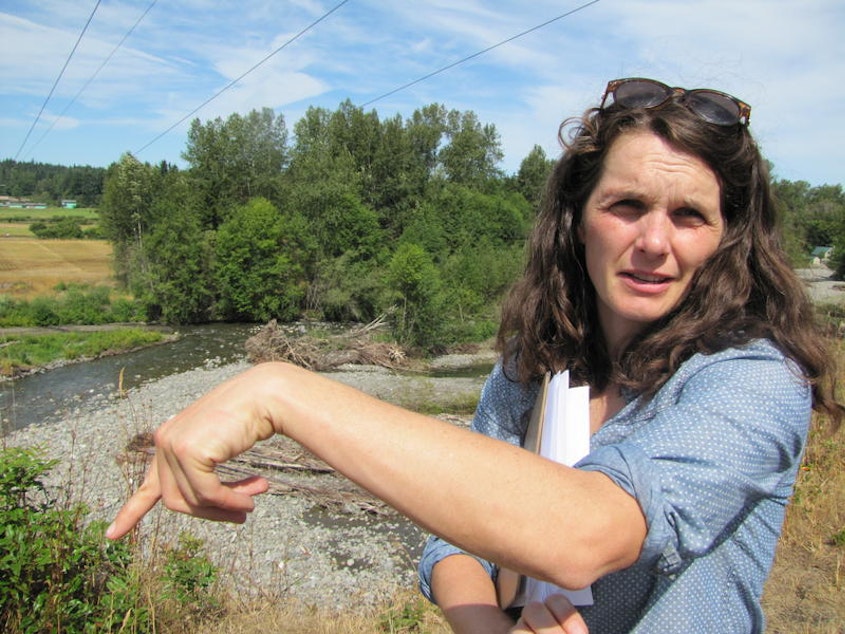Parched Olympic Peninsula Community Eyes New Reservoir

This is the first story in a two-part series on how drought and climate change are changing how the Northwest relies on reservoirs to meet water needs.
SEQUIM, Wash. – For more than a century, the snowmelt that fed the Dungeness River here has provided water for farmers’ crops as well as salmon journeying to the ocean and back.
The system has worked well – except when there’s not enough water. And now that this part of Washington’s Olympic Peninsula is caught in the drought afflicting much of the West, interest in building a new reservoir is on the rise. For longtime advocate Gary Smith, that’s a good thing.
“This project has been on the board for 20 years,” said Smith, who owns Maple View Farm near Sequim. “In the long term there’s no way to solve our problems other than storage if we want to maintain water in the river in the late part of the summer.”
This spot in the Olympic Peninsula’s rain shadow faces the same challenge confronting many places in the West as climate change sets in.
Climate models indicate that a rise in average temperatures means that more of the precipitation in the winter and spring months will take the form of rain instead of snow. That will bring more years like this, when there’s little if any snowpack in the mountains to melt and feed into rivers during the summer and early fall. “Water supply is not a year-round problem. It’s a question of timing and a question of that late season and finding solutions. That’s why we think this project might be a good fit,” said Amanda Cronin, project manager with Washington Water Trust. The nonprofit works with the state and communities to find better ways to conserve and manage water.
Cronin specified that the reservoir would not be created by blocking the river in any way. Instead some of its flow would be diverted during certain times of year into an 88-acre reservoir on land currently owned by the Washington Department of Natural Resources.
Work crews would need to remove 700,000 cubic yards of dirt to create the reservoir outside of Sequim. The manmade lake would be lined to prevent the water from draining into the sandy soil. The 319-acre section of DNR land would be open to the public for recreational use, as it is now.
The estimated price tag for the reservoir project is $32 million. Cronin and others have said it should be a candidate for state funding, though they have not formally approached elected officials.
“It’s expensive, but I think if any basin can do it, there’s very strong partnerships in the Dungeness,” Cronin said. “Given the broad coalition of folks that are supporting this, I think it has a chance.”
The state Department of Ecology has expressed initial support for the project, as has the Department of Fish and Wildlife. The Department of Natural Resources has permitted initial geotechnical analysis for the project.
The past winter’s sparser-than-usual snowfall could be what normal winters are like in the future, said Chase Gallagher with the Washington State Department of Ecology.
“As snowpack becomes less dependable, we’re going to need to look at different opportunities that manage both the supply side and the demand side of water,” Gallagher said, adding that means his agency is “going to be looking at a reservoir as an option for irrigators.”
The City of Sequim has incorporated the proposal into its storm water management planning. During heavy rains the city experiences flooding that causes irrigation ditches to overflow.
“We can intercept that water before it gets into the irrigation system and put it into the reservoir,” said Joe Holtrop, executive director of Clallam Conservation District.
“Understandably there’s some sticker shock with this project,” Holtrop acknowledged, “but I think 20 years from now, if we don’t do this, and the year that we’re having this year becomes more and more common, people are going to say, “Why didn’t we do something about that?” The proposed site of the reservoir is widely used by local outdoors recreationists. On a hot sunny morning, Jeff Becker and her horse, Vinnie, enjoyed a trail ride in a place that could one day be under water.
“I can see the point of maybe making a reservoir if it will help the situation with the water. It’s probably going to get drier in the future years, not wetter,” Becker said, adding that the DNR will eventually log the land anyway. “That may be a very good use for that land once all the trees come down.”
Proponents of the project hope to have the design completed by the end of 2016 with construction starting in 2017.
